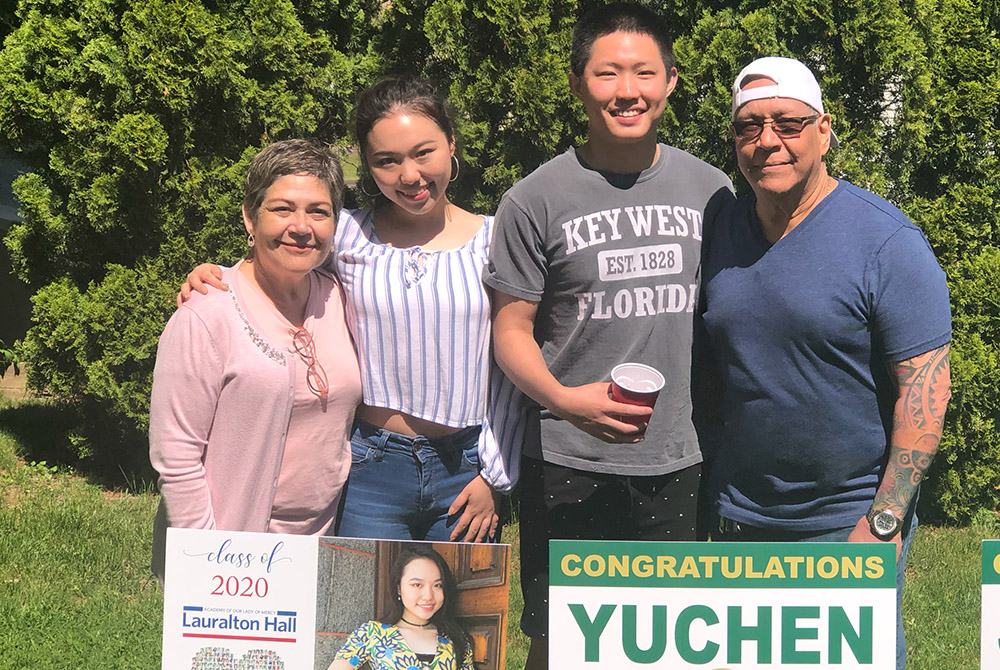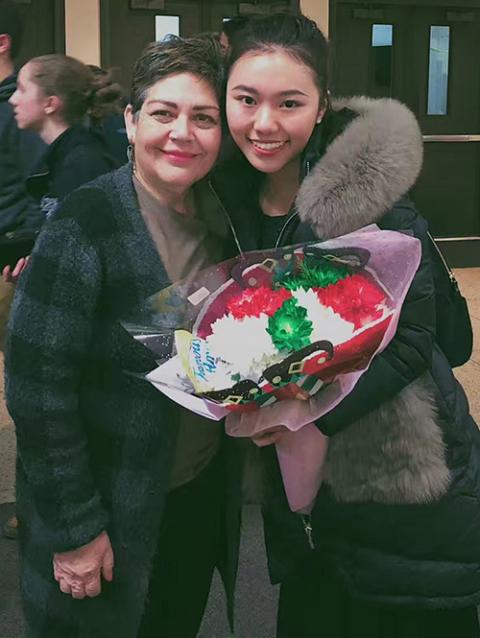
Jessica Wu, a Chinese international student who graduated from Our Lady of Mercy, Lauralton Hall in Milford, Conn. on June 20, 2020, is pictured with her boyfriend Jerry and her host parents Lucy and Junior. (Provided photo)
When Jessica Wu, 18, started high school at Our Lady of Mercy, Lauralton Hall in Milford, Connecticut, four years ago, she was realizing her dream. She loves America, and, like thousands of other Chinese students who have flocked to U.S. Catholic high schools in the last decade, she was looking for a path to American higher education.
But Wu, now headed to the University of Washington, does not know if she would have made the same choice now that she did back then.
The coronavirus has not only sickened millions across the globe, but made visas nearly impossible to come by, canceled most international flights, squeezed parents' pocketbooks, and stoked anti-Chinese prejudice in the U.S. All of that makes the calculus to attend an American Catholic school more difficult for foreign students.

Jessica Wu is pictured with her host mother Lucy after a school choir concert. (Provided photo)
"I would probably step back to wait and see what the situation is going to be, and then make a decision," Wu said. "I'm not probably going to take a gap year; I probably would study in a high school in China."
That kind of thinking is raising concerns at Catholic high schools around the country, according to Kathy Mears, CEO of the Arlington, Virginia, based National Catholic Education Association.
"The schools know that there will be far fewer international students, and in many cases, there won't be international students," she said.
Catholic schools began recruiting such students, most of them Chinese, 15 years ago in order to bring the church's teachings to international students and diverse perspectives from around the globe to their domestic students.
"The other side of it is it provided cash for the schools. Chinese students would pay an out-of-state, out-of-country rate and that was helpful to Catholic schools," Mears said.
By 2014, Foreign Policy magazine reported there were nearly 14,500 Chinese students enrolled in Catholic secondary education. Mears said that number hit its high-water mark around 2016 before leveling off.
Now, however, the coronavirus threatens to put a dent in international enrollment, causing problems for schools' increasingly important diversity goals and increasingly stressed balance sheets.
Tricia Roos, director of admissions at Bishop Lynch High School west of downtown Dallas, said the school has received zero international applicants this spring, normally the peak admissions period.
A student from the United Arab Emirates has already decided not to enroll and two more from the UAE and the Philippines could go the same way, Roos wrote in an email.
"I'm sure we will see many students, primarily Chinese, potentially not returning that were enrolled last year that are international students," she said.
The vast majority of Catholic high schools find students through international student recruiting agencies, like Apex International Education Partners in Derby, Connecticut, which places students at parochial schools throughout the northeast.
David Guerrera, AIEP's president of U.S. operations, said there are three things that need to happen if international students are to return to the U.S. in the fall: schools need to reopen, flights from China must restart, and visa offices in China have to begin processing applications again.
Guerrera is confident schools will open their doors in September, but the other two hurdles could delay the arrival of international students, and some may be waiting for months.
In early June the U.S. and China announced a series of back-and-forth changes to travel restrictions between the two countries. As reported by The Washington Post on June 5, U.S. officials announced that they would allow Chinese airlines "to operate the same number of flights that China is allowing U.S. carriers to operate between the two countries"; in addition, while Chinese carriers had been operating four flights a week, "under the new order, Chinese carriers would be limited to two weekly scheduled flights."
The U.S. suspended visa processing in mainland China in early February, and Guerrera said there are rumors that the closures could last until November.
Across the country at Justin-Siena High School in Napa, California, director of admissions Alicia Valdivia has similar concerns and puts the odds at fifty-fifty that the school retains all of its international students.
"It really depends on if they can get their visas, if they can get a flight to the United States, and then what are the parameters when they do set foot in the United States?" she said. "Right now, we're just waiting to see what the government says about travel restrictions."
At Archbishop Williams High School in Braintree, Massachusetts, director of admissions Michela Schuster said that while she worries about the 15 new students she recruited for next year, there are a number of factors that make her optimistic they will maintain their numbers.
The majority of the international students stayed in the U.S. with their host families through the pandemic, meaning those who did not graduate will be able to pick up their studies in the fall with everyone else. For the new students and those who cannot return, the school has purchased high tech software and cameras so students can join their classes virtually from abroad.
Many schools are allowing students to defer a semester while the situation stabilizes.
In high school admissions departments across the country, the coronavirus is actually only the latest challenge to international enrollment, particularly Chinese enrollment. The wave of Chinese students seems to have crested three or four years ago and has since plateaued or declined.
Melbourne Central Catholic on Florida's Space Coast started its international program in the wake of the Great Recession and by 2016 foreign students made up nearly 20% of the student body, according to Principal Ernest Herrington.
Since then international enrollment has plunged by 70 students to just 15 last year.
"COVID is affecting us a little bit, but the trend toward a drop in international students really started three to four years ago," Herrington said. "Part of it is the Parkland shooting … Parkland, which is actually three hours away, just seemed like a car ride."
Catholic school administrators nationwide also cite school shootings as a driver of the decline as well as rising international tensions with China and increased competition from high schools in Canada and Australia.
Advertisement
Janah Valenzuela, who manages international programs at Bishop Blanchet High School on the northside of Seattle, said the switch to online learning has been tough on the school's 12 international students and their families.
"It's been a really stressful, anxiety-inducing time for them. My kids, a lot of them are really depressed," she said. "Their parents feel a lot of that lack of control, they physically cannot come into the country to come and get their babies."
It is for some of those very reasons Jessica Wu said she would study in China if she were in the shoes of incoming freshmen. But then she paused.
"If I decide to come here, that this is my dream, then it would always be my dream. I would probably wait and see, but eventually my goal is to come here and study," she said.
[Alexander Thompson is a Boston-based freelance journalist who has worked for local papers in Ohio, Massachusetts and Senegal. He is also a student at Tufts University and covers local government for The Tufts Daily.]








